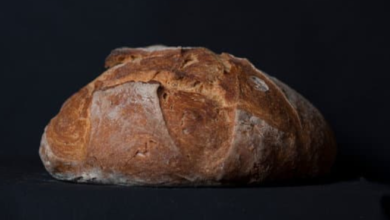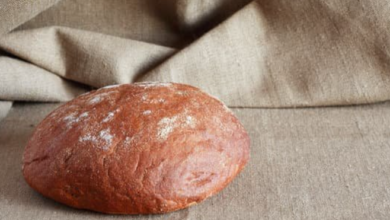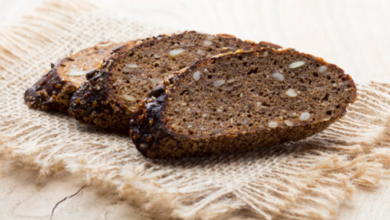What Is Rye Bread? – Everything You Need To Know
What To Know
- Unlike its wheat counterpart, rye bread boasts a darker hue, a dense texture, and a slightly sour tang that sets it apart from the crowd.
- A tangy and aromatic bread made with a sourdough starter, resulting in a slightly sour flavor and a chewy texture.
- Rye bread is made from rye flour, which gives it a darker color, denser texture, and a slightly sour flavor.
Rye bread, a delectable culinary creation, has captivated taste buds for centuries with its distinctive flavor and nutritional prowess. Unlike its wheat counterpart, rye bread boasts a darker hue, a dense texture, and a slightly sour tang that sets it apart from the crowd. Its unique characteristics stem from the inclusion of rye flour, a finely ground powder derived from the rye grain.
A Historical Odyssey: The Origins of Rye Bread
The origins of rye bread can be traced back to ancient civilizations, where it was a staple food among various cultures. In the fertile lands of the Middle East, rye bread formed an integral part of the diet as early as 5000 BC. Over time, its popularity spread throughout Europe, where it became a beloved bread choice in countries such as Germany, Poland, and Russia.
The Art of Rye Bread Baking: A Culinary Masterpiece
Crafting rye bread is an art form that requires precision and patience. The process begins with the selection of high-quality rye flour, which is then combined with water, yeast, and a touch of salt. The dough is kneaded until it achieves a smooth and elastic consistency, ensuring the development of gluten strands that give the bread its characteristic texture.
After a period of fermentation, the dough is shaped into loaves and allowed to rise once more before being baked in a preheated oven. The baking process transforms the dough into a golden-brown masterpiece, exuding an enticing aroma that fills the air.
Nutritional Treasures: Unlocking the Health Benefits of Rye Bread
Beyond its delectable flavor, rye bread is a nutritional powerhouse packed with an array of health-promoting nutrients. It is an excellent source of dietary fiber, which aids in digestion and promotes satiety. Rye bread also contains a significant amount of complex carbohydrates, providing sustained energy throughout the day.
Furthermore, rye bread is rich in essential vitamins and minerals, including B vitamins, iron, and magnesium. These nutrients play vital roles in maintaining a healthy nervous system, supporting blood cell production, and regulating muscle function.
Rye Bread Varieties: A Culinary Kaleidoscope
The world of rye bread is a diverse tapestry of flavors and textures, with each variety offering a unique gustatory experience. Some of the most popular types include:
- Pumpernickel Bread: A dark and dense bread made from coarsely ground rye flour, known for its slightly sweet flavor and long shelf life.
- Sourdough Rye Bread: A tangy and aromatic bread made with a sourdough starter, resulting in a slightly sour flavor and a chewy texture.
- Marble Rye Bread: A visually striking bread that combines both rye and wheat flour, creating a marbled appearance and a mild flavor.
- Caraway Rye Bread: A fragrant bread infused with caraway seeds, adding a distinctive nutty flavor and aroma.
Pairing Rye Bread: Culinary Harmony
The versatility of rye bread makes it a perfect accompaniment to a wide range of culinary creations. Its hearty texture and robust flavor pair well with both sweet and savory dishes.
- Breakfast: Spread rye bread with cream cheese and smoked salmon for a delectable morning treat.
- Lunch: Create a hearty sandwich with rye bread, sliced ham, Swiss cheese, and a tangy mustard.
- Dinner: Serve rye bread alongside a bowl of creamy mushroom soup or a grilled steak with roasted vegetables.
- Snacks: Enjoy rye bread with a dollop of hummus or a smear of your favorite nut butter.
Rye Bread: A Culinary Legacy for Generations
Through the annals of time, rye bread has remained a beloved culinary staple, cherished for its distinctive flavor, nutritional value, and versatility. From humble beginnings in ancient civilizations to its widespread popularity today, rye bread continues to grace tables and delight taste buds across the globe.
Top Questions Asked
Q: What is the difference between rye bread and wheat bread?
A: Rye bread is made from rye flour, which gives it a darker color, denser texture, and a slightly sour flavor. Wheat bread, on the other hand, is made from wheat flour and has a lighter color, softer texture, and a milder flavor.
Q: Is rye bread gluten-free?
A: No, rye bread is not gluten-free. Rye flour contains gluten, a protein that gives bread its elastic texture.
Q: Is rye bread healthier than wheat bread?
A: Rye bread is generally considered to be healthier than wheat bread due to its higher fiber content and lower glycemic index. Fiber helps promote satiety and supports digestive health, while a lower glycemic index helps regulate blood sugar levels.
Q: How do I store rye bread?
A: Rye bread can be stored at room temperature for 2-3 days. For longer storage, it can be wrapped in plastic wrap and frozen for up to 3 months.
Q: Can I make rye bread at home?
A: Yes, it is possible to make rye bread at home with a bread machine or by hand. However, the process is more complex than making wheat bread due to the gluten content of rye flour.




